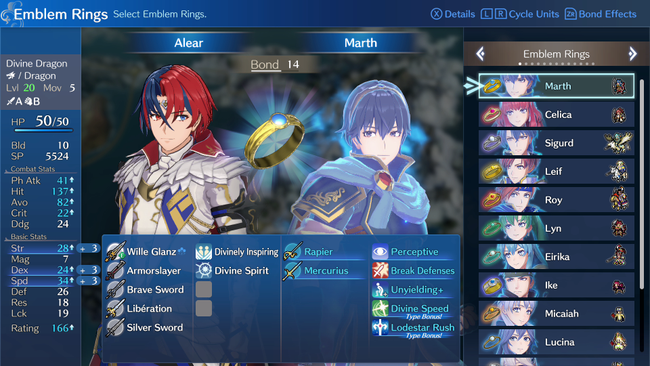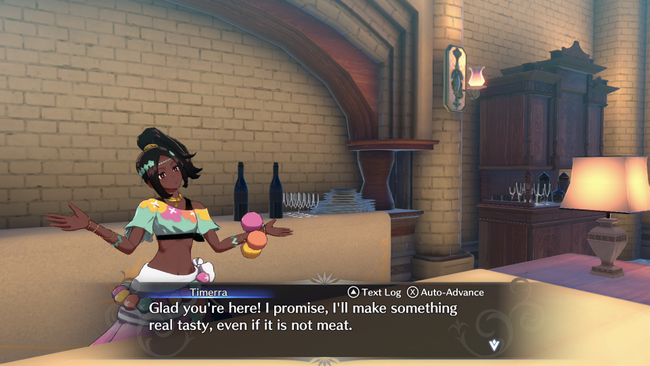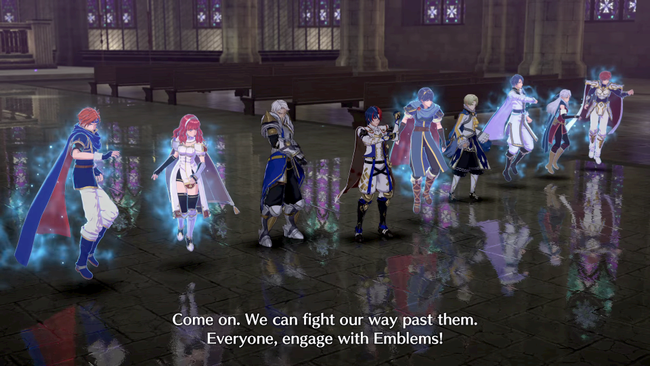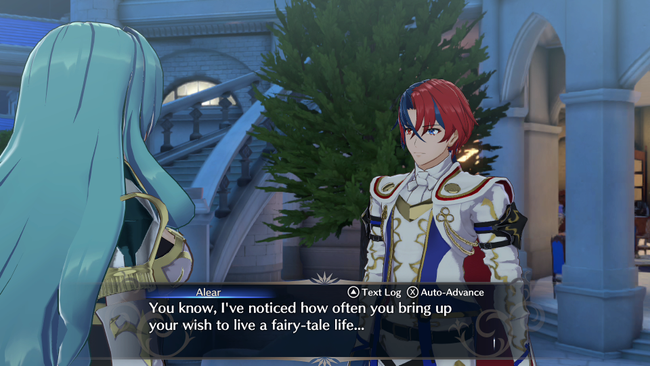
Fire Emblem Engage Review
Twenty years ago, I remember the anticipation before Fire Emblem's release on the Game Boy Advance. Those of us in the West only really knew of Marth & Roy, thanks to their inclusion in Super Smash Bros. Melee. It became something of a meme, back then, to ask "are Marth and Roy in this game?", because that was all that most people knew. We collectively learned at the time that Fire Emblem, later known as Fire Emblem: The Blazing Blade, was actually the seventh game in the series, just the first to be released in English.
I bought Fire Emblem on a whim, not really sure what to think going into it. I had played a lot of RPGs, but not a lot of tactical games at the time. Turns out, I loved it. A mix of great art, good tactics, and a serviceable enough cast & story were enough to hook me, so I'm glad to see the series twenty years later become one of Nintendo's mainstay franchises. Fire Emblem Engage, the newest entry, frames itself as a sort of celebratory title, including callbacks to nearly every title in the series. And yes, Marth & Roy are in it.
While different Fire Emblem games may excel in different facets with their own mechanical twists, they generally all have the same core tactical gameplay stylings, with some entries offering their own unique take on the formula. Support Conversations became vogue in the GBA era, the 3DS era focused on offspring and character heritage, while Three Houses added a school/calendar system to the usual tactical mix, etc.

This time around, Fire Emblem Engage's defining component is the Emblem system. If you've paid attention to pre-release marketing at all, you've seen this already. Twelve main characters from previous Fire Emblem titles all make an appearance in Engage, not really as playable characters, but as "Emblems". Housed in a ring, these Emblem characters offer new abilities, skills, and weapons to the characters that wear them. If you give Alear - Engage's main character - the Emblem Ring for Marth, Alear will gain access to the Rapier weapon, Lodestar Rush ability, as well as various passive skills that raise evasion.
Other Emblems offer their own unique weapons and abilities to the character that wields them. Ike offers support for tanking skills & axe weapons, Micaiah greatly improves healing capacity, Lyn can shoot down enemies from a distance, Celica offers many bonuses useful for magic-casting characters, and so on. However, these Emblem bonuses can only be used for a handful of turns before needing to recharge, so knowing when to activate the Emblem becomes crucial as well.
This is where the real meat of Engage's gameplay lies, and it is what allows Engage to stand out from other Fire Emblem titles. Since any character can wield any Emblem Ring, the list of possible Character/Emblem permutations is massive. Certain characters are undoubtedly more well-suited to certain Emblems, but sometimes unexpected combos work out better than they may initially seem. Sigurd is useful to have on pretty much any character, for instance, thanks to how he increases movement range.

Using Emblems will also add to a character's proficiency with different types of weapons. The weapon proficiency system in Engage works a little bit differently than in previous games, and getting into the specific details might be a little too dry here, but know that by using certain Emblems on your characters, they can gain weapon proficiencies they would not earn otherwise. And based on a character's weapon proficiencies, the number of advanced classes that they'll be able to promote into will also increase.
Combat and the Emblem mechanics are what I enjoyed most about Fire Emblem Engage. If you typically come to Fire Emblem titles primarily for their gameplay components, you should not be disappointed. For veterans of the series, the game's Normal mode will probably feel too easy, allowing you to Save at any point in battle and rewind turns an unlimited number of times. There is a Hard mode available, offering a more moderate challenge while also limiting the number of rewinds to ten per battle, although you can still Save whenever you want. Unlike Three Houses, a Maddening Mode is also available from launch (rather than in a post-launch update), so those looking for a significant challenge should be able to find it here. This mode also prevents Saving in battle, as it should.
Veterans of the series are also very curious about map design in Fire Emblem titles, and how Engage compares to past entries. I personally feel Engage's maps are not as tight as some like Fire Emblem Fates: Conquest, which featured a rewarding variety of different win & loss conditions, as well generally far more tense battle scenarios. To me, Engage's maps feel just a notch better than Three Houses, with better implementation of possible chokepoints and less ability to turtle or deathball your way to victory. However, looking back on it, Three Houses probably had slightly better objective variety than Engage, with notably more unique Survive & Defend objectives in that game's paralogue slate, at least.

In between battles, you'll be spending time at the Somniel, which is essentially your home base floating in the sky. This is most similar to the Monastery in Three Houses where you can have a respite before taking on the next mission. This is where the game design of Fire Emblem Engage starts to get a little bit weird. The game throws an inordinate amount of non-combat subsystems here, and it can actually almost feel a bit overwhelming.
You can do strength training for a temporary and minor stat boost. You can ride a wyvern, Panzer Dragoon style. You can feed a pet dog-thing. You can adopt animals for your animal pen. You can do tarot readings. You can buy clothes at the boutique. You can fish. You can pick up random scattered items. You can have meals with your allies. You can spar with your allies or emblems at the Arena. You can sleep in your bed and have an ally wake you up. You can polish Emblem Rings. You can do trial battles at the Tower of Trials. You can forge your regular weapons or use gems on Engage weapons. You can donate funds to nations to get items & weapons. You can earn several hundred in-game achievements. There's A Lot.
Luckily, most of the fluff systems found at the Somniel are optional, and many of them aren't really worth taking the time to do. For instance, polishing rings gives you a slight bond increase between a character and Emblem, but I did it once and never again, since you'll bond plenty by doing story battles or skirmishes. The temporary boosts from strength training aren't worth the time the minigame takes to do it. Wyvern rides take way too long for a handful of Bond Fragments you'll get numerous other ways. Trial battles rewards are measly considering the amount of time they take. My advice, genuinely, is to ignore almost all of it.
Despite this detritus of optional activities you can do, there is a key reason why the overall pacing of Fire Emblem Engage is snappier than that of Three Houses - there is no calendar system. And with no calendar, there are no lectures. I personally felt that motivation/lecture/skill/proficiency systems in Three Houses synergized pretty well, despite slowing things down a tad. But it's not something I desired in every Fire Emblem game going forward, and indeed it's absent here.
That means it's easier to move the story along from story battle to story battle, if you desire, keeping faster pacing throughout. Those who were put off due to the lecture/calendar system should feel a bit of relief here.

While the tactical gameplay components of Fire Emblem Engage were interesting & unique enough to greatly compel me, I wish I could say the same for its narrative elements and character cast.
One of the things I most appreciated about Fire Emblem Three Houses was how we learned about the world and its inhabitants through Support conversations with the cast of characters. Each student and staff had a different path in life in arriving at Garreg Mach Monastery, and their life story not only expanded on that character's being and personality, but also the world of Fodlan itself. Each character's storyline also eventually resulted in a Paralogue battle in order to resolve some conflict in their personal history, contributing to both character-building and world-building in that game world - not to mention Paralogue battles tended to have better map design and objective variety anyways.
Supports in Engage are much less concerned with building a believable world, instead opting to lean more heavily into each character's exaggerated personality gimmicks. Each character has one or two quirks that essentially become the sole-defining element of their being. While quirky Fire Emblem characters are nothing new, I found that past games were more successfully able to balance their gimmicks with some respectable character writing.

Some of these personality quirks are admittedly amusing on a surface level - it's fun to see the once-tribal-now-noble girl overcompensating her feral past through exaggerated formal speech - but there's very little depth to it. Especially considering the sheer number of Support conversations in Engage, seeing each character repeatedly bring about their gimmick time and again gets old, fast. Celine likes tea, Diamant likes training, Anna wants to sell stuff, Timerra likes meat, Chloe likes fairy tales, etc. It's fine for a conversation or two, but when everyone is a one-trick pony, the "skip scene" option starts looking a lot more tempting.
Out of the numerous Support Conversations in the game, there is a small handful that breaks away from the mold, offering a little bit of insight into a character or the world, but these are the exception to the more hijinks-oriented banter between magnified eccentricities.
Additionally, for the most part, Engage trades away character-focused Paralogues with Emblem-focused Paralogues. Each of the Twelve Emblem characters has their own Paralogue battle, which also works as a throwback to the Fire Emblem title that they came from. These battles recreate a map from their respective title, and they also come with a remixed musical track from their entry. This is clearly placed as nostalgia for fans of the series, and as someone who has played almost every title in the series (I still need to try the original Fire Emblem Gaiden), sure, it's fun to revisit those moments! But as a tradeoff, it also leaves the world and characters of Elyos with considerably less to work with.
The main narrative of Fire Emblem Engage also leaves a lot to be desired. Without getting into anything that could be a spoiler, the premise is very straightforward, mostly coming down to a MacGuffin Hunt as Alear and company work to collect the twelve Emblem Rings. Plot movement feels very pro forma as the party circles the continent looking for Emblem Rings, and any potential "twists" are easily predictable, all culminating in a battle against Mr. McBadGuy with a flimsy villainous motive. There's just very little substance to it, which is disappointing.
For those who started their Fire Emblem journey with Awakening/Fates and latched onto those games' pairing & romance mechanics, know that romance once again takes a back seat in Fire Emblem Engage; certainly less than Awakening/Fates and even more so than Three Houses from my perspective. By the end of the game, there is an S-Support equivalent that Alear can have with any other character of his or her choosing, and you'll get a unique piece of CG art like you would in Three Houses, but to me, it largely feels tacked in order to include it in the game out of some sense of obligation rather than anything more meaningful or compelling. Maybe just the act of being able to partner with another character will be satisfying enough to those looking forward to that, but it certainly doesn't come across as much more than an obligatory inclusion.

It almost goes without saying, but Fire Emblem Engage is easily the best-looking game in the series - at least among the 3D entries - as far as visual fidelity and model animations go. Everything is clean and sharp in a dramatic improvement from Three Houses, there are plenty of well-animated pre-rendered movies, and most importantly, battle animations are the best they've ever been. Over the course of the game, there's a chance you'll still turn off animations eventually once you've seen them hundreds of times, but it's clear a lot of effort was made in making combat sequences fluid and exciting.
Fire Emblem Engage is a good tactical RPG with a paper-thin story, shallow characters, and a kitchen-sink approach to far too many subsystems that don't synergize well. If you come to Fire Emblem primarily for its tactical elements, you may have an absolute blast building your perfect team of colorful combatants and their Emblem counterparts. I come away from Fire Emblem Engage satisfied with its tried-and-true gameplay and unique Emblem twist, but I wish the narrative elements made more of an impact on me.